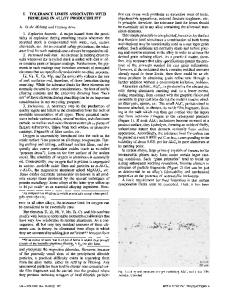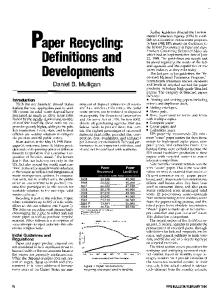Aluminum: Recycling and Carbon/Environmental Footprint
- PDF / 186,315 Bytes
- 2 Pages / 593.972 x 792 pts Page_size
- 104 Downloads / 410 Views
https://doi.org/10.1007/s11837-020-04325-y Ó 2020 The Minerals, Metals & Materials Society
ALUMINUM: RECYCLING AND CARBON / ENVIRONMENTAL FOOTPRINT
Aluminum: Recycling and Carbon/Environmental Footprint DAVID S. WONG
,1,4 ANNE KVITHYLD,2 and HONG PENG3
1.—Atmolite Consulting Pty Ltd, Gold Coast, QLD 4227, Australia. 2.—SINTEF Industry, Trondheim, Norway. 3.—School of Chemical Engineering, The University of Queensland, Brisbane, QLD 4072, Australia. 4.—e-mail: [email protected]
This special topic presents some of the latest technical developments and research into managing the aluminum industry’s sustainability challenges. As covered by an informative panel discussion article in this month’s issue of JOM: The Magazine, the magnitude of these challenges is significant. For instance, the International Aluminium Institute estimates that to meet the United Nations Sustainable Development Goals, with all its requirements for materials and energy resources (including renewables), primary aluminum production globally may need to increase another 25–30 million tons per year by 2050, on top of 2020s 65 million tons. At this scale, the industry’s current challenges will continue to intensify, including the need for ethical and sustainable mining of bauxite with a demand of 500 million tons/year, large-scale solutions to manage the 250 million tons of bauxite residue/year from alumina refining, and the need for the industry—particularly smelters and alumina refineries—to shift toward low-carbon energy mixes if it is to make an impact on reducing greenhouse gas emissions. Recycling has always been important and would reduce the intensity of sustainability challenges faced by primary production. This has recently drawn new attention because of increasing environmental awareness and as a key element of a circular economy. However, a circular economy will never take place without real (physical) solutions. These vast sustainability challenges must be met by increased collaboration and sharing of knowledge, best practices, and technological advances across the industry, on a global scale, such as those described in the articles presented in this special David Wong, Anne Kvithyld, and Hong Peng are guest editors for the Aluminum Committee of TMS and also for the Recycling and Environmental Technologies Committee of TMS. They organized the special topic Aluminum: Recycling and Carbon/Environmental Footprint in this issue. (Received July 13, 2020; accepted July 31, 2020)
topic of JOM. The following seven articles focus on the recycling of aluminum (and its alloys) as well as mitigating the environmental ramifications of both primary and secondary aluminum production. The first article, ‘‘Developing Guidance to Support Sustainable Spent Pot Lining (SPL) Management across the Aluminum Industry,’’ addresses the topic of spent pot lining, a fluoride and cyanide-containing hazardous, solid waste from the aluminum smelting process. Here, P. Nunez tracks the International Aluminium Institute’s (IAI) development of an industry gui
Data Loading...











